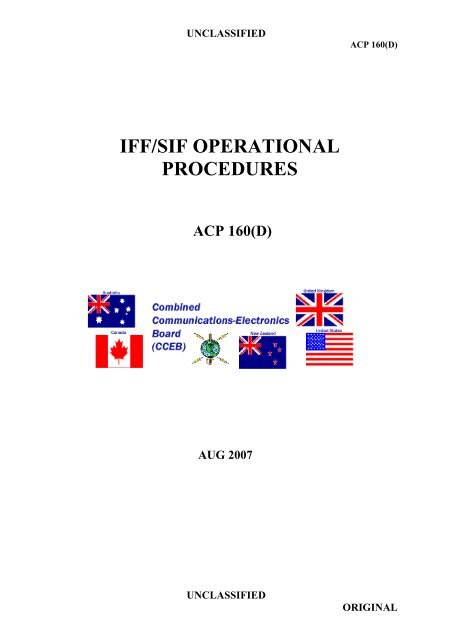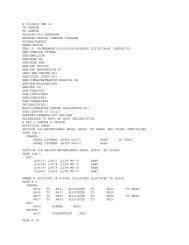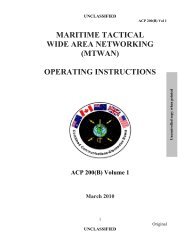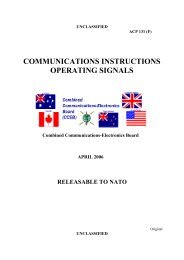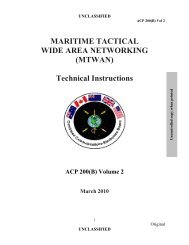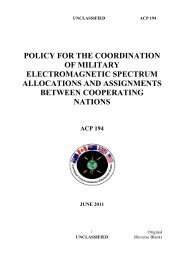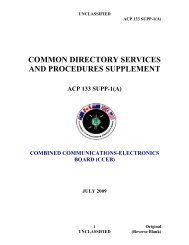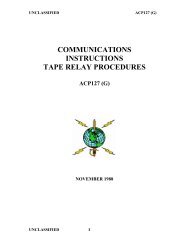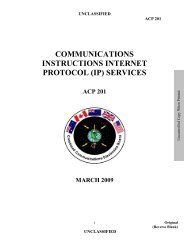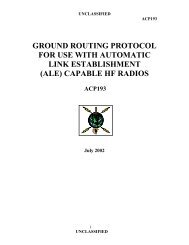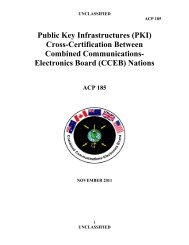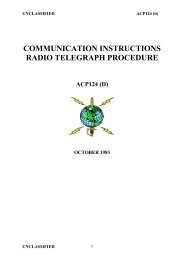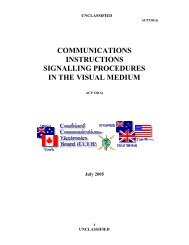IFF/SIF OPERATIONAL PROCEDURES
IFF/SIF OPERATIONAL PROCEDURES
IFF/SIF OPERATIONAL PROCEDURES
Create successful ePaper yourself
Turn your PDF publications into a flip-book with our unique Google optimized e-Paper software.
UNCLAS<strong>SIF</strong>IED<br />
<strong>IFF</strong>/<strong>SIF</strong> <strong>OPERATIONAL</strong><br />
<strong>PROCEDURES</strong><br />
ACP 160(D)<br />
AUG 2007<br />
UNCLAS<strong>SIF</strong>IED<br />
ACP 160(D)<br />
ORIGINAL
UNCLAS<strong>SIF</strong>IED<br />
FOREWORD<br />
i<br />
UNCLAS<strong>SIF</strong>IED<br />
ACP 160(D)<br />
1. The Combined Communications-Electronics Board (CCEB) is comprised of the five<br />
member nations, Australia, Canada, New Zealand, United Kingdom and United States and is<br />
the sponsoring authority for all Allied Communications Publications (ACPs). ACPs are raised<br />
and issued under common agreement between the member nations.<br />
2. ACP 160(D), <strong>IFF</strong>/<strong>SIF</strong> Operational Procedures, is an UNCLAS<strong>SIF</strong>IED Allied<br />
Communication Publication (ACP). Periodic accounting is not required.<br />
3. This publication contains Allied military information for official purposes only.<br />
4. It is permitted to copy or make extracts from this publication without consent of the<br />
Authorising Agency.<br />
5. This ACP is to be maintained and amended in accordance with the provisions of ACP<br />
198.<br />
ORIGINAL
UNCLAS<strong>SIF</strong>IED<br />
CCEB LETTER OF PROMULGATION<br />
FOR ACP 160(D)<br />
ii<br />
UNCLAS<strong>SIF</strong>IED<br />
ACP 160(D)<br />
1. The purpose of this Combined Communication Electronics Board (CCEB) Letter of<br />
Promulgation is to implement ACP 160(D) within the Armed Forces of the CCEB Nations.<br />
ACP 160(D) <strong>IFF</strong>/<strong>SIF</strong> Operational Procedures is an UNCLAS<strong>SIF</strong>IED publication developed for<br />
Allied use and, under the direction of the CCEB Principals. It is promulgated for guidance,<br />
information, and use by the Armed Forces and other users of military communications<br />
facilities.<br />
2. ACP 160(D) is effective on receipt for CCEB Nations and effective for NATO nations<br />
and Strategic Commands when promulgated by the NATO Military Committee (NAMILCOM).<br />
ACP 160(D) will supersede ACP 160(C), which shall be destroyed in accordance with national<br />
regulations.<br />
EFFECTIVE STATUS<br />
Publication Effective for Date Authority<br />
ACP 160(D) CCEB On Receipt LOP<br />
3. All proposed amendments to the publication are to be forwarded to the national coordinating<br />
authorities of the CCEB or NAMILCOM.<br />
For the CCEB Principals<br />
JA STOTT<br />
Lt Cdr RN<br />
Permanent Secretary to CCEB<br />
ORIGINAL
UNCLAS<strong>SIF</strong>IED<br />
RECORD OF MESSAGE CORRECTIONS<br />
Identification of Message Correction<br />
and date of same<br />
Date, Time<br />
Group<br />
Correction<br />
Date<br />
Entered<br />
iii<br />
UNCLAS<strong>SIF</strong>IED<br />
ACP 160(D)<br />
By whom entered<br />
(Signature; rank, grade or<br />
rate; name of command)<br />
ORIGINAL
UNCLAS<strong>SIF</strong>IED<br />
TABLE OF CONTENTS<br />
iv<br />
UNCLAS<strong>SIF</strong>IED<br />
ACP 160(D)<br />
FOREWORD.......................................................................................................................................................i<br />
CCEB LETTER OF PROMULGATION ...........................................................................................................ii<br />
RECORD OF MESSAGE CORRECTIONS.....................................................................................................iii<br />
TABLE OF CONTENTS ..................................................................................................................................iv<br />
CHAPTER 1.......................................................................................................................................................1-1<br />
GENERAL INSTRUCTIONS.........................................................................................................................1-1<br />
PURPOSE....................................................................................................................................................1-1<br />
SECURITY CLAS<strong>SIF</strong>ICATION ................................................................................................................1-1<br />
OBSERVATION OF SELECTIVE IDENTIFICATION FEATURE (<strong>SIF</strong>) RESPONSES.........................1-1<br />
CHAPTER 2.......................................................................................................................................................2-1<br />
<strong>IFF</strong> SYSTEMS ................................................................................................................................................2-1<br />
INTRODUCTION .......................................................................................................................................2-1<br />
BASIC <strong>IFF</strong> MARK X SYSTEMS...............................................................................................................2-1<br />
<strong>IFF</strong> MARK X (<strong>SIF</strong>) .....................................................................................................................................2-1<br />
<strong>IFF</strong> MARK X (A) ........................................................................................................................................2-1<br />
<strong>IFF</strong> MARK XII............................................................................................................................................2-1<br />
<strong>IFF</strong> MARK XII (S) ......................................................................................................................................2-1<br />
<strong>IFF</strong> MARK XII (A) .....................................................................................................................................2-1<br />
<strong>IFF</strong> SYSTEMS ............................................................................................................................................2-2<br />
CHAPTER 3.......................................................................................................................................................3-1<br />
<strong>IFF</strong>/<strong>SIF</strong> COMMON OPERATING CHARACTERISTICS ............................................................................3-1<br />
DESCRIPTION ...........................................................................................................................................3-1<br />
OPERATION...............................................................................................................................................3-2<br />
CHAPTER 4.......................................................................................................................................................4-1<br />
TECHNICAL SPECIFICATIONS..................................................................................................................4-1<br />
GENERAL ..................................................................................................................................................4-1<br />
BASIC <strong>IFF</strong> MARK X..................................................................................................................................4-1<br />
<strong>IFF</strong> MARK X (<strong>SIF</strong>) .....................................................................................................................................4-1<br />
<strong>IFF</strong> MARK X(A).........................................................................................................................................4-1<br />
<strong>IFF</strong> MARK XII............................................................................................................................................4-1<br />
<strong>IFF</strong> MARK XII (A) .....................................................................................................................................4-2<br />
CHAPTER 5.......................................................................................................................................................5-1<br />
RESPONSIBILITY .........................................................................................................................................5-1<br />
COMMANDERS RESPONSIBILITY........................................................................................................5-1<br />
ORIGINAL
PURPOSE<br />
UNCLAS<strong>SIF</strong>IED<br />
CHAPTER 1<br />
GENERAL INSTRUCTIONS<br />
1-1<br />
UNCLAS<strong>SIF</strong>IED<br />
ACP 160(D)<br />
101. The purpose of this publication is to briefly describe <strong>IFF</strong> systems and to provide a<br />
basis for establishing operational procedures and equipment policy. More specialist/technical<br />
information and operational procedures may be found in national or Regional Defence<br />
Organization publications. <strong>IFF</strong> systems have been adopted for the primary function of<br />
assisting in the rapid and positive identification of friendly units and secondly, assisting in the<br />
tracking and control of aircraft. Although considered an identification device, <strong>IFF</strong> systems<br />
are normally used in conjunction with other means (eg RADARs, flight plan correlation,<br />
voice authentication, and so forth) to provide identification of friend or foe.<br />
SECURITY CLAS<strong>SIF</strong>ICATION<br />
102. <strong>IFF</strong> equipment and related technical information is Unclassified, with the exception of<br />
technical data on security equipment for Mark XII, which is Confidential.<br />
103. Documents containing information on the tactical use of <strong>IFF</strong> equipment (including<br />
doctrine and procedures) will be classified Secret.<br />
104. Documents containing guidance (including doctrine and procedures) for only nontactical<br />
(for instance Air Traffic Control, Air/Sea Rescue) employment of <strong>IFF</strong> systems will be<br />
Unclassified.<br />
OBSERVATION OF SELECTIVE IDENTIFICATION FEATURE (<strong>SIF</strong>) RESPONSES<br />
105. All operators of <strong>IFF</strong> interrogation equipment must be highly skilled in recognising<br />
and interpreting <strong>SIF</strong> responses as displayed on their equipment whether computerised or<br />
manual. In particular, operators should appreciate the distinction between Normal,<br />
Identification of Position (IDENT I/P), and Emergency responses.<br />
ORIGINAL
INTRODUCTION<br />
UNCLAS<strong>SIF</strong>IED<br />
CHAPTER 2<br />
<strong>IFF</strong> SYSTEMS<br />
2-1<br />
UNCLAS<strong>SIF</strong>IED<br />
ACP 160(D)<br />
201. The purpose of this chapter is to provide an unclassified description of the <strong>IFF</strong><br />
systems in current NATO service and those being introduced into Service in the near future.<br />
Table 2-1 provides a summary of all these systems, including the facilities that they provide.<br />
BASIC <strong>IFF</strong> MARK X SYSTEMS<br />
202. Basic Mark X is the oldest <strong>IFF</strong> system still in operational use by friendly nations. It<br />
has the ability to reply by mode only (no codes are available from the transponder). IDENT<br />
(I/P) and EMERGENCY features are available. A LOW receiver sensitivity position is also<br />
available. Certain nations restrict the use of basic Mark X transponder equipped aircraft.<br />
<strong>IFF</strong> MARK X (<strong>SIF</strong>)<br />
203. To improve the flexibility for operational use of the basic Mark X system, the Mark X<br />
(<strong>SIF</strong>) was adopted. Newer <strong>IFF</strong> systems have a <strong>SIF</strong> feature built in. The <strong>SIF</strong> system allows<br />
for the identification of individual aircraft rather than just whether it is Friend or Foe. The<br />
<strong>SIF</strong> adds reply pulse coding to the basic Mark X system and provides added capability for<br />
performing identification, and the tracking and control of friendly aircraft. The <strong>SIF</strong> addition<br />
to the basic Mark X, because of its low inherent security, does not provide positive<br />
identification of friend or foe. The numbers of codes available from the Mark X (<strong>SIF</strong>)<br />
equipment are 32 in Mode 1, 4096 in Mode 2, and 64 in Mode 3. IDENT (I/P) and<br />
EMERGENCY features are also available.<br />
<strong>IFF</strong> MARK X (A)<br />
204. Mark X (A) is essentially the same as Mark X (<strong>SIF</strong>) except that Mode 3 provides<br />
4096 codes and Secondary Surveillance Radar (SSR) Mode C, which provides for automatic<br />
pressure altitude reporting.<br />
<strong>IFF</strong> MARK XII<br />
205. Mark XII is essentially the same as <strong>IFF</strong> Mark X (A) but has the addition of Mode 4,<br />
which provides for secure positive friendly identification.<br />
<strong>IFF</strong> MARK XII (S)<br />
206. Mark XII (S) is the same as <strong>IFF</strong> Mark XII but has the addition of Mode S (Select).<br />
Mode S is a civil aviation initiative to overcome deficiencies associated with SSR Mode 3/A<br />
and C. It provides unique aircraft identification, enhanced Mode C height resolution and<br />
flight details through the transmission of Downlinked Air Parameters (DAPs).<br />
<strong>IFF</strong> MARK XII (A)<br />
207. Mark XII (A) has the same features as <strong>IFF</strong> Mark XII and the additional capabilities of<br />
the secure Mode 5 waveform. Mode 5 provides 4 graduated levels of data transmission with<br />
ORIGINAL
UNCLAS<strong>SIF</strong>IED<br />
2-2<br />
UNCLAS<strong>SIF</strong>IED<br />
ACP 160(D)<br />
enhanced security protection. Mode 5 has 4 graduated levels of capabilities; Level 1 provides<br />
a Question and Answer Identification (including a unique Platform Identification Number<br />
(PIN) and a classified ‘LETHAL’ interrogation format), Level 2 Position Reporting, Level 3<br />
Selective Interrogation and Level 4 Data Exchange.<br />
<strong>IFF</strong> SYSTEMS<br />
BASIC <strong>IFF</strong> MARK X <strong>IFF</strong> MARK X (<strong>SIF</strong>) <strong>IFF</strong> MARK X (A)<br />
Mode 1 Mode 1 - 32 Codes Mode 1 –32 Codes<br />
Mode 2 Mode 2 – 4096 Codes Mode 2 - 4096 Codes<br />
Mode 3 (not normally selectable in (not normally selectable in<br />
flight)<br />
flight)<br />
Mode 3 - 64 Codes Mode 3 - 4096 Codes<br />
SSR Mode C<br />
IDENT (I/P) IDENT (I/P) IDENT (I/P)<br />
EMERGENCY EMERGENCY EMERGENCY<br />
<strong>IFF</strong> MARK XII <strong>IFF</strong> MARK XII(S) <strong>IFF</strong> MARK XII (A)<br />
Mode 1 –32 Codes Mode 1 –32 Codes Mode 1 –32 Codes<br />
Mode 2 - 4096 Codes Mode 2 - 4096 Codes Mode 2 - 4096 Codes<br />
(not normally selectable in (not normally selectable in (not normally selectable in<br />
flight)<br />
flight)<br />
flight)<br />
Mode 3 - 4096 Codes Mode 3 - 4096 Codes Mode 3 - 4096 Codes<br />
Mode 4 - secure mode Mode 4 - secure mode Mode 4 - secure mode<br />
SSR Mode C SSR Mode C Mode 5 - secure mode, PIN<br />
IDENT (I/P) SSR Mode S SSR Mode C<br />
EMERGENCY DAPs<br />
(Downlinked Air Parameters)<br />
IDENT (I/P) IDENT (I/P)<br />
EMERGENCY EMERGENCY<br />
LETHAL<br />
Table 2-1<br />
ORIGINAL
DESCRIPTION<br />
UNCLAS<strong>SIF</strong>IED<br />
CHAPTER 3<br />
3-1<br />
UNCLAS<strong>SIF</strong>IED<br />
ACP 160(D)<br />
<strong>IFF</strong>/<strong>SIF</strong> COMMON OPERATING CHARACTERISTICS<br />
301. Introduction. <strong>IFF</strong> systems consist of interrogators, transponders, processing<br />
equipment, and related antenna systems. The antennas may or may not be associated with, or<br />
slaved to, a primary surveillance radar. In operation, an interrogation pulse pair or pulse train<br />
transmitted from the interrogator transmitter unit triggers each transponder located in the<br />
direction of the main beam causing a reply to be transmitted by the transponders. These<br />
replies are received by the interrogator receiver and, after processing, are displayed to the<br />
operator. Measurement of the time between transmission of the interrogation pulse and<br />
receipt of the transponder reply determines the range of the replying transponder while the<br />
mean direction of the main beam of the interrogator antenna, during the reply, determines the<br />
azimuth. The arrangement of the multiple-pulse reply provides identifying information and,<br />
in certain cases, pressure altitude of the responding aircraft.<br />
302. Modes. To differentiate between interrogations for different purposes, several modes<br />
of operation have been adopted. Technical details of civil modes are contained in Annex 10<br />
to ICAO Convention. Technical details of military modes are contained in national and<br />
Regional Defence Organization documents. In the military environment, there are five<br />
modes of operation known by Arabic numerals as Modes 1 through 5. In the Civil Air<br />
Traffic Control environment, <strong>IFF</strong> is called Secondary Surveillance Radar (SSR). The civil<br />
modes are known by letter designators as Modes A, B, C and D. The basic civil SSR mode<br />
is Mode A and is identical in most characteristics to the military Mode 3; as a consequence,<br />
this mode is commonly referred to as Mode 3/A. Modes 3 and A differ mainly in the<br />
characteristics of their EMERGENCY response. The second civil SSR mode is Mode B,<br />
which has very limited usage and has no military equivalent. Mode C is reserved for<br />
automatic pressure altitude transmission. Use of the fourth civil SSR mode, Mode D, has not<br />
been determined internationally. Military Modes 1, 2, 4 and 5 are not used in the civil SSR<br />
system. An additional civil Mode called Mode S is being developed. This is designed to use<br />
selective interrogation only and is expandable to include Downlink Aircraft Parameters.<br />
303. IDENT Functions. In addition to selecting the mode to which the transponder will<br />
reply and the code setting within that mode, aircrews can add to the reply. One addition is<br />
the I/P or Special Position Identification (SPI) feature. When selected in Mode 1, two pulse<br />
trains containing the code in use are transmitted. When selected in Modes 2 or 3, this feature<br />
activates the transmission of an additional pulse 4.35 microseconds after the last framing<br />
pulse.<br />
304. EMERGENCY Feature. The EMERGENCY response feature may be selected by the<br />
aircrew to cause the transponder to reply to any mode of interrogation with a distinctive reply<br />
of four pulse trains spaced 4.35 microseconds between trains. In more modern <strong>IFF</strong> systems,<br />
the EMERGENCY response feature of the 4096 code capable Mode 3/A radar beacon system<br />
will be coded 7700 for civil aircraft in all responses and 7700 in the first train of a four-train<br />
response for military users. Many existing military transponders (Mark X) (<strong>SIF</strong>) may<br />
transmit Code 000 for the last three trains. Mark XII Mode 3/A will provide Code 7700 in<br />
the first train followed by three trains of Code 000. Additionally, Code 7600 shall be used on<br />
Mode 3/A to provide recognition of an aircraft with radio communication failure. Code 7500<br />
ORIGINAL
UNCLAS<strong>SIF</strong>IED<br />
3-2<br />
ACP 160(D)<br />
shall be used on Mode 3/A to provide recognition that an aircraft has hijackers on board or is<br />
suffering from unlawful interference.<br />
OPERATION<br />
305. The following modes of operation have been adopted for world-wide use:<br />
Mode 1. Known as the General Identification Signal and beacon assist. In older<br />
transponders, Mode 1 is automatically selected for transmission when the transmitter<br />
is turned on. In more modern transponders, Mode 1 is available by switch setting.<br />
When <strong>SIF</strong> is available, aircrews can select any one of 32 reply codes.<br />
Mode 2. Known as the individual identification mode. Aircrews can select whether<br />
or not the transponder will reply to mode interrogation. Mode 2 code selection is not<br />
readily aircrew selectable. There are 4096 codes available.<br />
Mode 3. Aircrews can select by switch setting whether or not the transponder will<br />
reply to Mode 3 interrogation. Within Mode 3 are 4096 available reply codes.<br />
However, some older equipment has a reduced capability in Mode 3 of only 64 codes.<br />
Mode 4. Provides for positive secure friend identification. Mode 4 may be switched<br />
in or out by the aircrews in accordance with operational requirements.<br />
Mode 5. Provides enhanced secure friend identification. Mode 5 may be switched in<br />
or out by the aircrew in accordance with operational requirements. Each platform will<br />
be assigned its own unique PIN.<br />
306. Identification of Position (I/P) or Special Position Identification (SPI). There are<br />
three available switch settings within this function. IDENT (I/P) - OUT - MIC.<br />
Transponders are normally operated with this switch in the OUT position. The switch is<br />
spring loaded so that it returns to the OUT position when released from the IDENT (I/P)<br />
position. When activated in the IDENT (I/P) position, the transponder replies with a special<br />
response for each interrogation. This condition continues for from 15 to 30 seconds after<br />
release of the switch, after which the transponder will reply with a normal response. The<br />
MIC position operates in the same manner as the IDENT (I/P) position. For instance,<br />
whether MIC is selected and the pilot’s microphone switch is depressed, the transponder<br />
replies with a special response lasting for from 15 to 30 seconds. In those aircraft in which<br />
the MIC position is not interconnected with the radio transmitter, this position has no<br />
function.<br />
307. EMERGENCY (Distress) Feature. This signal response is selectable by transponder<br />
switch setting. When selected, it will cause the transponder to reply to each interrogation<br />
with four pulse trains spaced 4.35 microseconds between trains. This provides a distinctive<br />
display for recognition by operators at the interrogating location. EMERGENCY transponder<br />
replies will continue to be transmitted with each interrogation until the aircrew changes the<br />
switch setting. While the selection of the emergency signal by the aircrew will cause the<br />
transponder to reply, in the appropriate manner, there are times in which the signal can cause<br />
erroneous indications at the interrogating location (for instance, when tracks cross at different<br />
altitudes). Therefore, the Mode 3/A EMERGENCY response feature will include the use of<br />
certain code settings to ensure recognition of the emergency at all times. The code selected<br />
will be 77 or 7700, depending on the type of transponder. Code 76 or 7600 is reserved for<br />
UNCLAS<strong>SIF</strong>IED<br />
ORIGINAL
UNCLAS<strong>SIF</strong>IED<br />
3-3<br />
ACP 160(D)<br />
recognition of an aircraft with radio communications failure. Code 7500 shall be used on<br />
Mode 3/A to provide recognition that an aircraft has hijackers on board or is suffering from<br />
unlawful interference.<br />
308. LOW Position (Transponders). The LOW position can be selected for operation of<br />
the transponder. This setting reduces the receiver sensitivity of the airborne transponder, thus<br />
reducing the reply rate. Transponders will be operated in LOW position upon direction of the<br />
controlling agency or in accordance with local directives. Although the majority of<br />
transponders in operation have the LOW position available, certain modern transponders and<br />
interrogators have side lobe suppression (SLS) and beam sharpening methods available that<br />
eliminate the need for a LOW position.<br />
309. Surface Transponders. Controls for ground and surface transponders are very similar<br />
to airborne transponders except that EMERGENCY, IDENT (I/P) and Mode C may be<br />
omitted.<br />
310. Codewords. The codewords used to manage operational use of <strong>IFF</strong> equipment are<br />
detailed at Table 3-1 and are derived from ACP 165 (F).<br />
<strong>IFF</strong> SYSTEM CODE WORDS<br />
CODE MEANING<br />
PARROT Military <strong>IFF</strong> transponder<br />
SQUAWK(ING) Operate <strong>IFF</strong> as indicated or <strong>IFF</strong> is operating as indicated for instance SQUAWK<br />
THREE CODE ZERO ZERO AND IDENT<br />
SQUAWK MAYDAY Turn <strong>IFF</strong> Master Control to EMERGENCY<br />
SQUAWK IDENT Activate <strong>IFF</strong> transponder I/P switch<br />
SQUAWK MIKE Place <strong>IFF</strong> switch to MIC. Make a short radio transmission<br />
SQUAWK LOW Turn <strong>IFF</strong> Master Control to LOW sensitivity position<br />
SQUAWK NORMAL Turn <strong>IFF</strong> Master Control to NORMAL<br />
SQUAWK STANDBY Turn <strong>IFF</strong> Master Control to Standby<br />
SQUAWK FOUR Turn mode 4 switch on<br />
STRANGLE Switch off equipment indicated<br />
………. SOUR Equipment indicated is not operating efficiently<br />
………. SWEET Equipment indicated is operating efficiently<br />
………. BENT Equipment indicated is inoperative. Cancelled by OKAY<br />
Table 3-1<br />
UNCLAS<strong>SIF</strong>IED<br />
ORIGINAL
GENERAL<br />
UNCLAS<strong>SIF</strong>IED<br />
CHAPTER 4<br />
TECHNICAL SPECIFICATIONS<br />
4-1<br />
UNCLAS<strong>SIF</strong>IED<br />
ACP 160(D)<br />
401. Detailed technical specifications of <strong>IFF</strong>/<strong>SIF</strong> equipment and instructions for its use are<br />
contained in appropriate Military Service publications and in ICAO Annex 10 for Air Traffic<br />
Control application. Only those technical specifications of use to operators of <strong>IFF</strong>/<strong>SIF</strong><br />
systems are included here.<br />
BASIC <strong>IFF</strong> MARK X<br />
402. The basic Mark X transponder reply for Modes 1 and 3 is a single pulse. The Mode 2<br />
response for aircraft is two pulses with 16-microsecond spacing. All basic Mark X<br />
transponders transmit Mode 2 information when the transponder is in LOW or NORMAL<br />
operation.<br />
<strong>IFF</strong> MARK X (<strong>SIF</strong>)<br />
403. When coding is added to basic Mark X transponder equipment, the replies are<br />
changed into pulse trains, consisting of two framing or bracket pulses spaced 20.3<br />
microseconds apart. Contained within these framing pulses is a series of up to 12 short (.45<br />
microsecond) information pulses, the presence or absence of which is determined by code<br />
selection in the transponder equipped vehicle.<br />
Mode 1 operation of the transponder uses up to five information pulse positions<br />
spaced 2.9 microseconds apart.<br />
Mode 2 operation of the transponder utilizes combinations of pulses out to a<br />
maximum of 13 pulse positions with a spacing of 1.45 microseconds, the seventh<br />
pulse position always being omitted. Certain Mark X (<strong>SIF</strong>) transponders transmit<br />
Mode 2 information when the transponder is LOW or NORMAL operation.<br />
Mode 3 operation uses up to six information pulse position spaced 2.9 microseconds<br />
apart.<br />
<strong>IFF</strong> MARK X(A)<br />
404. Mark X(A) is essentially the same as Mark X (<strong>SIF</strong>) except that Mode 3 operation of<br />
the transponder provides 4096 codes made possible by using additional combinations of pulse<br />
positions. Mark X(A) transponders are also Mode C capable of providing automatic pressure<br />
altitude reporting. Certain Mark X(A) transponders have a Mode 1 on and off switch.<br />
<strong>IFF</strong> MARK XII<br />
405. The Mark XII system contains all features of Mark X(A) with two additions. The<br />
primary addition is Mode 4, which provides a security coded response to suitably equipped<br />
interrogators. The Mark XII transponder also has an aircrew control Mode 1 on and off<br />
switch whereas most basic Mark X and certain Mark X (<strong>SIF</strong>) transponders always transmit<br />
Mode 1 information when the transponder is in LOW or NORMAL operation.<br />
ORIGINAL
<strong>IFF</strong> MARK XII (A)<br />
UNCLAS<strong>SIF</strong>IED<br />
4-2<br />
UNCLAS<strong>SIF</strong>IED<br />
ACP 160(D)<br />
406. The Mark XII (A) system provides all features of Mark XII with the addition of Mode<br />
5, which provides an enhanced security coded response to suitably equipped interrogators.<br />
Mode 5 employs spread spectrum data modulation, a spectrally efficient RF modulation<br />
technique known as minimum shift keying, higher capacity/ATC friendly waveforms and<br />
new cryptographic algorithm and security features with Time of Day authentication.<br />
407. There are four levels of operation. Level 1 provides 2 reply waveforms. The ID reply<br />
provides secure, positive friend identification only. The Data Reply provides 28 information<br />
bits, which will include the PIN of 14 bits. Level 2 adds a position reporting capability to the<br />
basic Level 1 Q&A mode. Each Level 2 reply contains latitude and longitude information<br />
along with format dependent reply data shown in Table 4-1. The technical characteristics of<br />
Levels 3 and 4 have not been fully defined.<br />
Data Field<br />
Mode 1<br />
Mode 2<br />
Mode 3<br />
Barometric Altitude<br />
Mission Code<br />
National Origin<br />
Platform Identification Number<br />
Emergency<br />
Identification of Position<br />
X Pulse<br />
Table 4-1<br />
ORIGINAL
COMMANDERS RESPONSIBILITY<br />
UNCLAS<strong>SIF</strong>IED<br />
CHAPTER 5<br />
RESPONSIBILITY<br />
501. Commanders are responsible for ensuring that personnel under their command<br />
concerned with <strong>IFF</strong> operation are cognizant of these instructions and that they are fully<br />
disseminated, thoroughly understood, and properly employed.<br />
5-1<br />
UNCLAS<strong>SIF</strong>IED<br />
ACP 160(D)<br />
502. The primary function of <strong>IFF</strong> systems is to assist in the rapid and positive identification<br />
of friendly units and secondly assisting in the tracking and control of aircraft. Tests and<br />
studies have revealed that <strong>IFF</strong> systems may suffer degradation due to interference in areas of<br />
high aircraft density and large numbers of interrogations. Commanders will therefore ensure<br />
that agencies under their command will not operate <strong>IFF</strong> interrogators except for the express<br />
purposes explained above without specific authority from the appropriate Theatre or Area<br />
Commander.<br />
503. In exceptional cases, necessary maintenance, operational checks, and evaluations may<br />
be performed on the <strong>IFF</strong> interrogators. Commanders will ensure <strong>IFF</strong>/<strong>SIF</strong> equipment is<br />
maintained in a manner to allow immediate operational use. Equipment may be used in<br />
exercises as required. However, such use must be kept to a minimum.<br />
504. Commanders will ensure that exercises that employ <strong>IFF</strong> systems are co-ordinated in<br />
advance, with host nation, or host nations, IAW established policies and procedures (eg<br />
Germany requires co-ordination in advance, to be followed up with quarterly reporting for<br />
Mode 4).<br />
505. Commanders are responsible for effecting operational control in a manner allowing<br />
for the performance of the Air Traffic Control function.<br />
ORIGINAL


